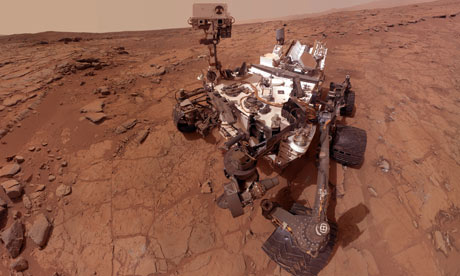 Curiosity, the latest rover to explore Mars, has found lots of water in the martian soil. Now, it doesn’t run freely, but is chemically bound to other substances. Yet the large volume of H2O bodes well for future human exploration (and settlement).
Curiosity, the latest rover to explore Mars, has found lots of water in the martian soil. Now, it doesn’t run freely, but is chemically bound to other substances. Yet the large volume of H2O bodes well for future human exploration (and settlement).
From the Guardian:
Water has been discovered in the fine-grained soil on the surface of Mars, which could be a useful resource for future human missions to the red planet, according to measurements made by Nasa’s Curiosity rover.
Each cubic foot of Martian soil contains around two pints of liquid water, though the molecules are not freely accessible, but rather bound to other minerals in the soil.
The Curiosity rover has been on Mars since August 2012, landing in an area near the equator of the planet known as Gale Crater. Its target is to circle and climb Mount Sharp, which lies at the centre of the crater, a five-kilometre-high mountain of layered rock that will help scientists unravel the history of the planet.
On Thursday Nasa scientists published a series of five papers in the journal Science, which detail the experiments carried out by the various scientific instruments aboard Curiosity in its first four months on the martian surface. Though highlights from the year-long mission have been released at conferences and Nasa press conferences, these are the first set of formal, peer-reviewed results from the Curiosity mission.
“We tend to think of Mars as this dry place – to find water fairly easy to get out of the soil at the surface was exciting to me,” said Laurie Leshin, dean of science at Rensselaer Polytechnic Institute and lead author on the Science paper which confirmed the existence of water in the soil. “If you took about a cubic foot of the dirt and heated it up, you’d get a couple of pints of water out of that – a couple of water bottles’ worth that you would take to the gym.”
About 2% of the soil, by weight, was water. Curiosity made the measurement by scooping up a sample of the Martian dirt under its wheels, sieving it and dropping tiny samples into an oven in its belly, an instrument called Sample Analysis at Mars. “We heat [the soil] up to 835C and drive off all the volatiles and measure them,” said Leshin. “We have a very sensitive way to sniff those and we can detect the water and other things that are released.”
Aside from water, the heated soil released sulphur dioxide, carbon dioxide and oxygen as the various minerals within it were decomposed as they warmed up.
One of Curiosity’s main missions is to look for signs of habitability on Mars, places where life might once have existed. “The rocks and minerals are a record of the processes that have occurred and [Curiosity is] trying to figure out those environments that were around and to see if they were habitable,” said Peter Grindrod, a planetary scientist at University College London who was not involved in the analyses of Curiosity data.
Flowing water is once thought to have been abundant on the surface of Mars, but it has now all but disappeared. The only direct sources of water found so far have been as ice at the poles of the planet.
Read the entire article here.
Image: NASA’s Curiosity rover on the surface of Mars. Courtesy: Nasa/Getty Images
